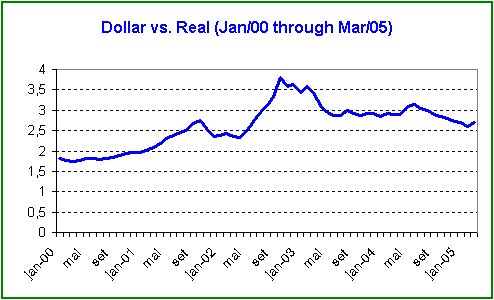Below, advertising
|
Dollar versus Real - 1999 to 2005

Click here to see the graphic from 1994 to 2005
From 1994 to 1999, following the deployment of Real Plan, the exchange rates in Brazil were tightly controlled by the Central Bank; click here to read more.
Since 1999, Brazil has adopted a monetary policy based on free floating currency and inflation target; the policy is complemented on the fiscal side by the realization of a big fiscal surplus.
Through 2000 and first half of 2001, the exchange rate moved gradually up, loosely following the internal inflation. Since 1997, Brazil had been in good standing with the IMF; towards the end of 2001, when speculations against the Brazilian currency were growing (Russia and Argentina had declared default on their debts), Brazil signed a new agreement with IMF, by which the country would withdraw another US$15bn. This seemed enough to protect the Real against any attack, and the dollar reced.
However, in 2002 Brazil held Presidential elections. From the beginning, the favorite candidate was Luís Inácio Lula da Silva, an ex-metal worker who always defended ideas like non-payment of debts, "protect workers from exploitation by capitalists" and such.
As a result, the dollar started a climbing from around R$2.50 in January to near R$4.00 in November, when Lula was elected. Investors were selling Reais, buying Dollars and sending them out of the country, to escape any radical interventions of the future President.
Lula took office in January 2003 and, to surprise of many, he didn´t change much in the Economy.
Actually, Lula confirmed the basic points of the previous government: floating currency, inflation targets and fiscal surplus. For the most important positions (Ministry of Finances, Central Bank, Revenue Service), Lula was careful in choosing people who were conservative (in the sense that there would be no rupture with the previous government).
More than that: President Lula was now supporting measures that Candidate Lula used to attack. Lula approved a reform in the Social Security of civil servants. Lula conceded a small increase to official minimum wage, much lower than what he used to promise. Lula cut several budget itens, even social investments.
The dollar returned to levels pre-election-2002. The foreigner surplus in 2004 was the highest ever, and seems to remain growing in 2005, suggesting that exporters should be happy with the current exchange rates.
Analysts, however, point some reasons which would lead the Real to devaluate in the near future:
- to pursue the inflation target (5.1% for 2005), the Central Bank is applying in Brazil the highest interest rate in the world. If political pressures oblige the Central Bank to reduce interest rates, the dollar may surge
- the international scenario has been tranquil over the past years, and the interest rates are low. If the FED starts increasing rates again, or if any other turbulence appears, the investments would fled from Brazil to more secure places, and the Dollar would gain value.
For a table and graphic with the exchange rate for the past three months, visit O Globo (quick registration required).
For today´s exchange rate, check out the frontpage of the Central Bank of Brazil.
Back to Top
|
|

